roof NISSAN ARMADA 2019 Owner´s Manual
[x] Cancel search | Manufacturer: NISSAN, Model Year: 2019, Model line: ARMADA, Model: NISSAN ARMADA 2019Pages: 536, PDF Size: 2.56 MB
Page 10 of 536
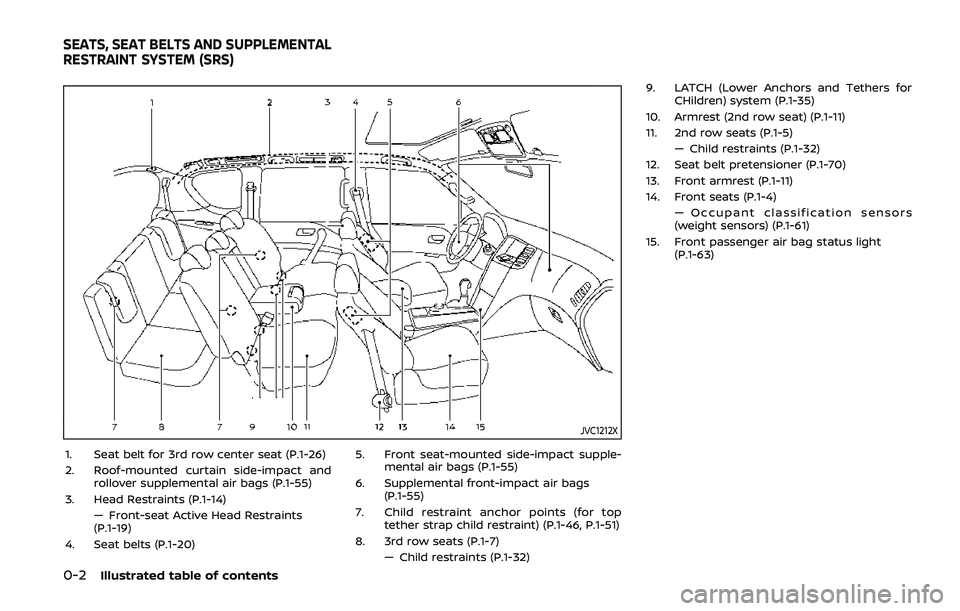
0-2Illustrated table of contents
JVC1212X
1. Seat belt for 3rd row center seat (P.1-26)
2. Roof-mounted curtain side-impact androllover supplemental air bags (P.1-55)
3. Head Restraints (P.1-14) — Front-seat Active Head Restraints
(P.1-19)
4. Seat belts (P.1-20) 5. Front seat-mounted side-impact supple-
mental air bags (P.1-55)
6. Supplemental front-impact air bags (P.1-55)
7. Child restraint anchor points (for top tether strap child restraint) (P.1-46, P.1-51)
8. 3rd row seats (P.1-7) — Child restraints (P.1-32) 9. LATCH (Lower Anchors and Tethers for
CHildren) system (P.1-35)
10. Armrest (2nd row seat) (P.1-11)
11. 2nd row seats (P.1-5) — Child restraints (P.1-32)
12. Seat belt pretensioner (P.1-70)
13. Front armrest (P.1-11)
14. Front seats (P.1-4) — Occupant classification sensors
(weight sensors) (P.1-61)
15. Front passenger air bag status light (P.1-63)
SEATS, SEAT BELTS AND SUPPLEMENTAL
RESTRAINT SYSTEM (SRS)
Page 11 of 536
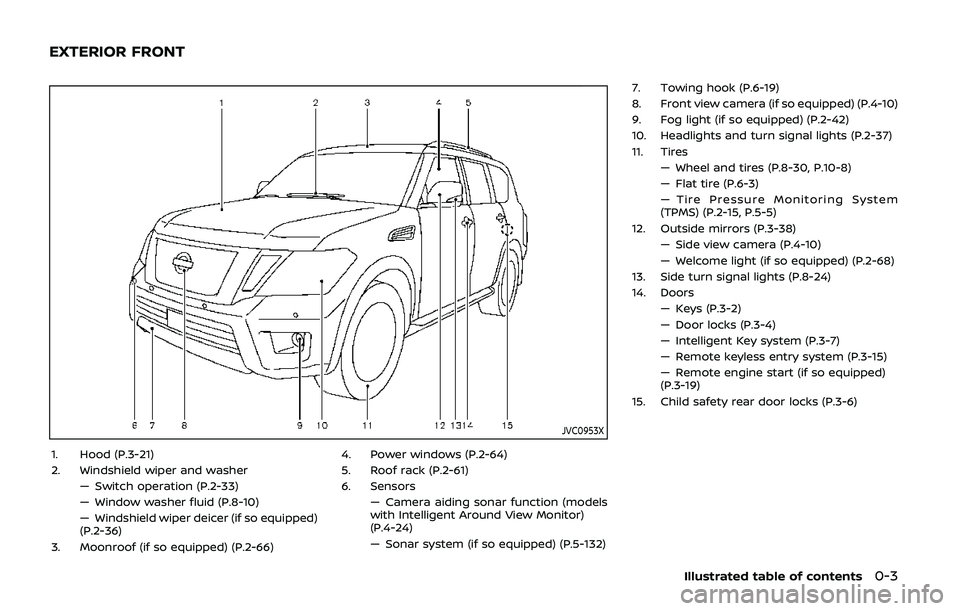
JVC0953X
1. Hood (P.3-21)
2. Windshield wiper and washer— Switch operation (P.2-33)
— Window washer fluid (P.8-10)
— Windshield wiper deicer (if so equipped)
(P.2-36)
3. Moonroof (if so equipped) (P.2-66) 4. Power windows (P.2-64)
5. Roof rack (P.2-61)
6. Sensors
— Camera aiding sonar function (models
with Intelligent Around View Monitor)
(P.4-24)
— Sonar system (if so equipped) (P.5-132) 7. Towing hook (P.6-19)
8. Front view camera (if so equipped) (P.4-10)
9. Fog light (if so equipped) (P.2-42)
10. Headlights and turn signal lights (P.2-37)
11. Tires
— Wheel and tires (P.8-30, P.10-8)
— Flat tire (P.6-3)
— Tire Pressure Monitoring System
(TPMS) (P.2-15, P.5-5)
12. Outside mirrors (P.3-38) — Side view camera (P.4-10)
— Welcome light (if so equipped) (P.2-68)
13. Side turn signal lights (P.8-24)
14. Doors — Keys (P.3-2)
— Door locks (P.3-4)
— Intelligent Key system (P.3-7)
— Remote keyless entry system (P.3-15)
— Remote engine start (if so equipped)
(P.3-19)
15. Child safety rear door locks (P.3-6)
Illustrated table of contents0-3
EXTERIOR FRONT
Page 13 of 536
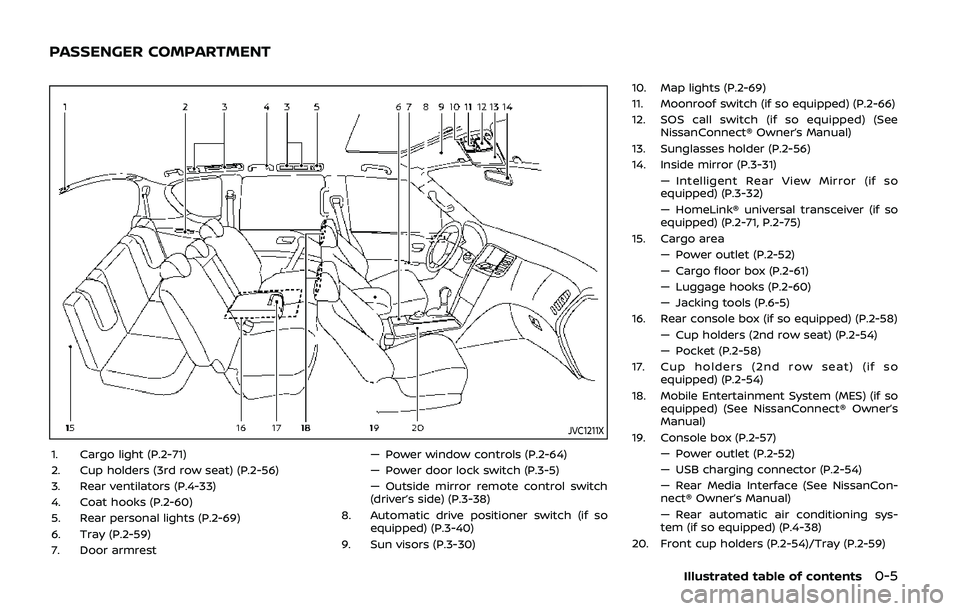
JVC1211X
1. Cargo light (P.2-71)
2. Cup holders (3rd row seat) (P.2-56)
3. Rear ventilators (P.4-33)
4. Coat hooks (P.2-60)
5. Rear personal lights (P.2-69)
6. Tray (P.2-59)
7. Door armrest— Power window controls (P.2-64)
— Power door lock switch (P.3-5)
— Outside mirror remote control switch
(driver’s side) (P.3-38)
8. Automatic drive positioner switch (if so equipped) (P.3-40)
9. Sun visors (P.3-30) 10. Map lights (P.2-69)
11. Moonroof switch (if so equipped) (P.2-66)
12. SOS call switch (if so equipped) (See
NissanConnect® Owner’s Manual)
13. Sunglasses holder (P.2-56)
14. Inside mirror (P.3-31) — Intelligent Rear View Mirror (if so
equipped) (P.3-32)
— HomeLink® universal transceiver (if so
equipped) (P.2-71, P.2-75)
15. Cargo area — Power outlet (P.2-52)
— Cargo floor box (P.2-61)
— Luggage hooks (P.2-60)
— Jacking tools (P.6-5)
16. Rear console box (if so equipped) (P.2-58) — Cup holders (2nd row seat) (P.2-54)
— Pocket (P.2-58)
17. Cup holders (2nd row seat) (if so equipped) (P.2-54)
18. Mobile Entertainment System (MES) (if so equipped) (See NissanConnect® Owner’s
Manual)
19. Console box (P.2-57) — Power outlet (P.2-52)
— USB charging connector (P.2-54)
— Rear Media Interface (See NissanCon-
nect® Owner’s Manual)
— Rear automatic air conditioning sys-
tem (if so equipped) (P.4-38)
20. Front cup holders (P.2-54)/Tray (P.2-59)
Illustrated table of contents0-5
PASSENGER COMPARTMENT
Page 22 of 536
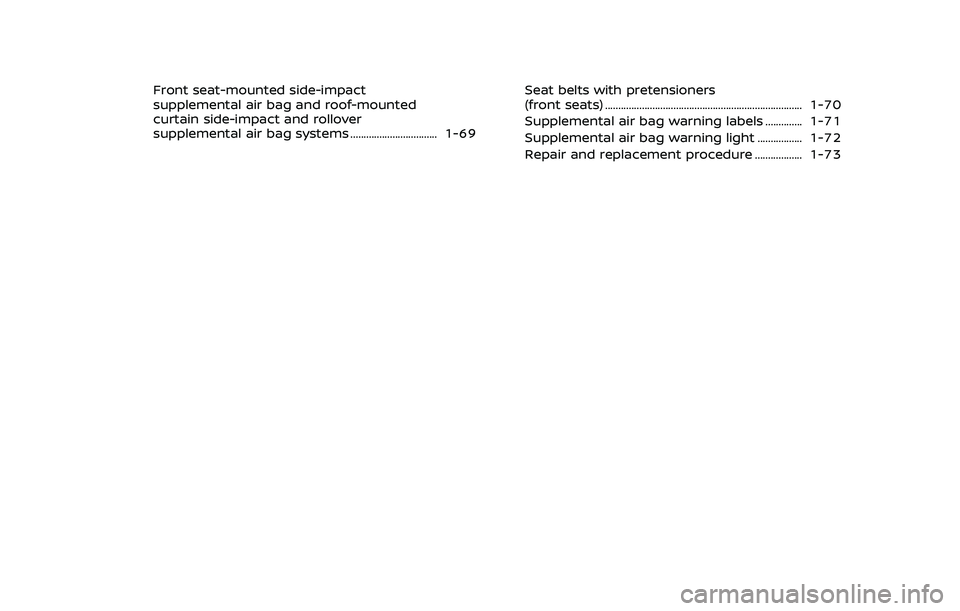
Front seat-mounted side-impact
supplemental air bag and roof-mounted
curtain side-impact and rollover
supplemental air bag systems ................................. 1-69Seat belts with pretensioners
(front seats) ........................................................................\
... 1-70
Supplemental air bag warning labels .............. 1-71
Supplemental air bag warning light ................. 1-72
Repair and replacement procedure .................. 1-73
Page 75 of 536
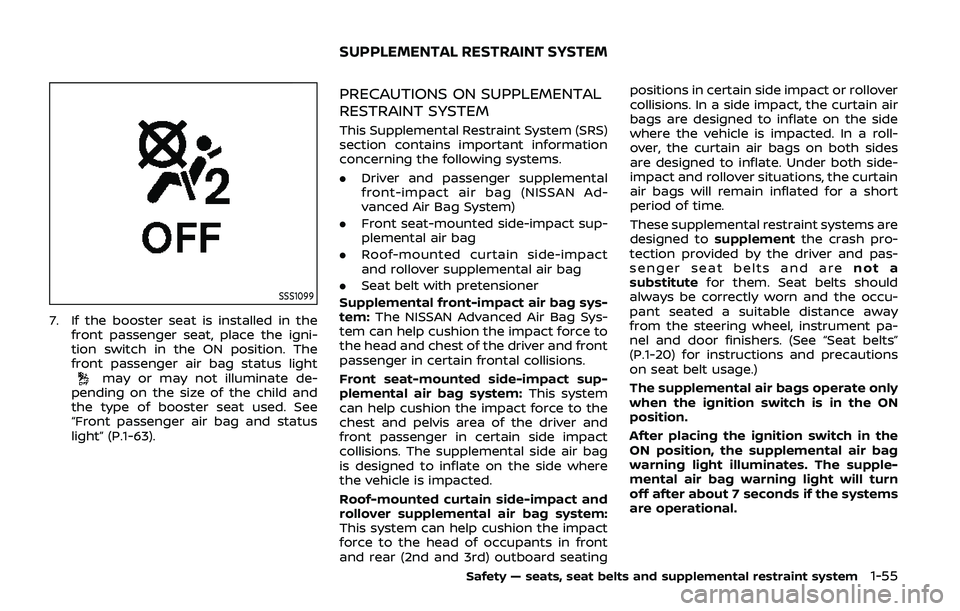
SSS1099
7. If the booster seat is installed in thefront passenger seat, place the igni-
tion switch in the ON position. The
front passenger air bag status light
may or may not illuminate de-
pending on the size of the child and
the type of booster seat used. See
“Front passenger air bag and status
light” (P.1-63).
PRECAUTIONS ON SUPPLEMENTAL
RESTRAINT SYSTEM
This Supplemental Restraint System (SRS)
section contains important information
concerning the following systems.
. Driver and passenger supplemental
front-impact air bag (NISSAN Ad-
vanced Air Bag System)
. Front seat-mounted side-impact sup-
plemental air bag
. Roof-mounted curtain side-impact
and rollover supplemental air bag
. Seat belt with pretensioner
Supplemental front-impact air bag sys-
tem: The NISSAN Advanced Air Bag Sys-
tem can help cushion the impact force to
the head and chest of the driver and front
passenger in certain frontal collisions.
Front seat-mounted side-impact sup-
plemental air bag system: This system
can help cushion the impact force to the
chest and pelvis area of the driver and
front passenger in certain side impact
collisions. The supplemental side air bag
is designed to inflate on the side where
the vehicle is impacted.
Roof-mounted curtain side-impact and
rollover supplemental air bag system:
This system can help cushion the impact
force to the head of occupants in front
and rear (2nd and 3rd) outboard seating positions in certain side impact or rollover
collisions. In a side impact, the curtain air
bags are designed to inflate on the side
where the vehicle is impacted. In a roll-
over, the curtain air bags on both sides
are designed to inflate. Under both side-
impact and rollover situations, the curtain
air bags will remain inflated for a short
period of time.
These supplemental restraint systems are
designed to
supplement the crash pro-
tection provided by the driver and pas-
senger seat belts and are not a
substitute for them. Seat belts should
always be correctly worn and the occu-
pant seated a suitable distance away
from the steering wheel, instrument pa-
nel and door finishers. (See “Seat belts”
(P.1-20) for instructions and precautions
on seat belt usage.)
The supplemental air bags operate only
when the ignition switch is in the ON
position.
After placing the ignition switch in the
ON position, the supplemental air bag
warning light illuminates. The supple-
mental air bag warning light will turn
off after about 7 seconds if the systems
are operational.
Safety — seats, seat belts and supplemental restraint system1-55
SUPPLEMENTAL RESTRAINT SYSTEM
Page 79 of 536
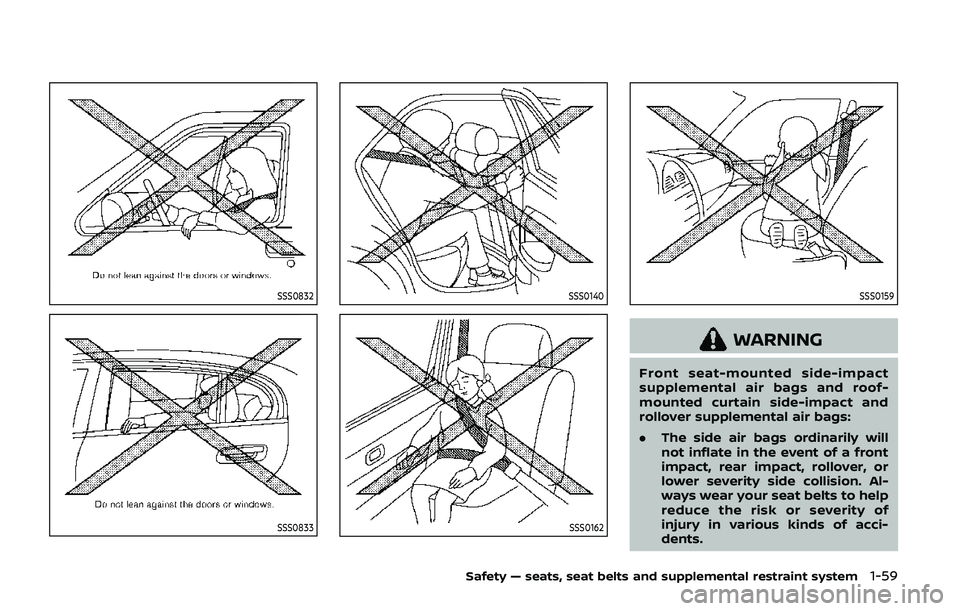
SSS0832
SSS0833
SSS0140
SSS0162
SSS0159
WARNING
Front seat-mounted side-impact
supplemental air bags and roof-
mounted curtain side-impact and
rollover supplemental air bags:
.The side air bags ordinarily will
not inflate in the event of a front
impact, rear impact, rollover, or
lower severity side collision. Al-
ways wear your seat belts to help
reduce the risk or severity of
injury in various kinds of acci-
dents.
Safety — seats, seat belts and supplemental restraint system1-59
Page 80 of 536
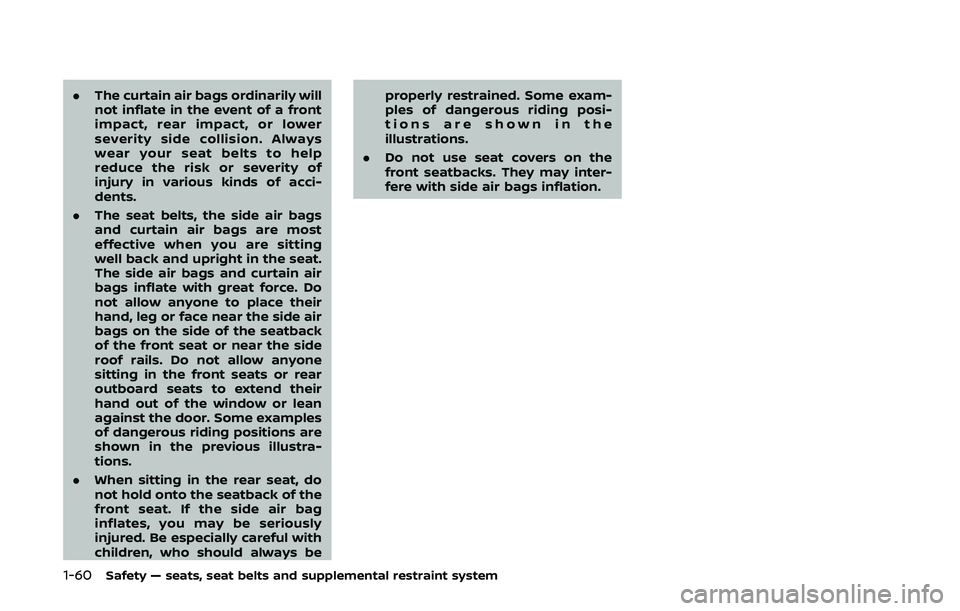
1-60Safety — seats, seat belts and supplemental restraint system
.The curtain air bags ordinarily will
not inflate in the event of a front
impact, rear impact, or lower
severity side collision. Always
wear your seat belts to help
reduce the risk or severity of
injury in various kinds of acci-
dents.
. The seat belts, the side air bags
and curtain air bags are most
effective when you are sitting
well back and upright in the seat.
The side air bags and curtain air
bags inflate with great force. Do
not allow anyone to place their
hand, leg or face near the side air
bags on the side of the seatback
of the front seat or near the side
roof rails. Do not allow anyone
sitting in the front seats or rear
outboard seats to extend their
hand out of the window or lean
against the door. Some examples
of dangerous riding positions are
shown in the previous illustra-
tions.
. When sitting in the rear seat, do
not hold onto the seatback of the
front seat. If the side air bag
inflates, you may be seriously
injured. Be especially careful with
children, who should always be properly restrained. Some exam-
ples of dangerous riding posi-
tions are shown in the
illustrations.
. Do not use seat covers on the
front seatbacks. They may inter-
fere with side air bags inflation.
Page 81 of 536
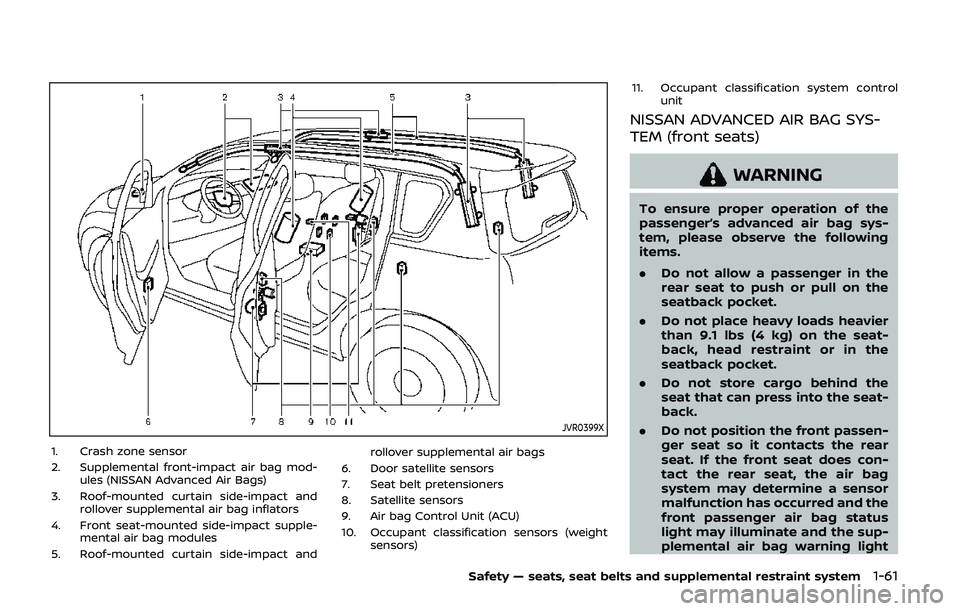
JVR0399X
1. Crash zone sensor
2. Supplemental front-impact air bag mod-ules (NISSAN Advanced Air Bags)
3. Roof-mounted curtain side-impact and rollover supplemental air bag inflators
4. Front seat-mounted side-impact supple- mental air bag modules
5. Roof-mounted curtain side-impact and rollover supplemental air bags
6. Door satellite sensors
7. Seat belt pretensioners
8. Satellite sensors
9. Air bag Control Unit (ACU)
10. Occupant classification sensors (weight sensors) 11. Occupant classification system control
unit
NISSAN ADVANCED AIR BAG SYS-
TEM (front seats)
WARNING
To ensure proper operation of the
passenger’s advanced air bag sys-
tem, please observe the following
items.
.Do not allow a passenger in the
rear seat to push or pull on the
seatback pocket.
. Do not place heavy loads heavier
than 9.1 lbs (4 kg) on the seat-
back, head restraint or in the
seatback pocket.
. Do not store cargo behind the
seat that can press into the seat-
back.
. Do not position the front passen-
ger seat so it contacts the rear
seat. If the front seat does con-
tact the rear seat, the air bag
system may determine a sensor
malfunction has occurred and the
front passenger air bag status
light may illuminate and the sup-
plemental air bag warning light
Safety — seats, seat belts and supplemental restraint system1-61
Page 89 of 536
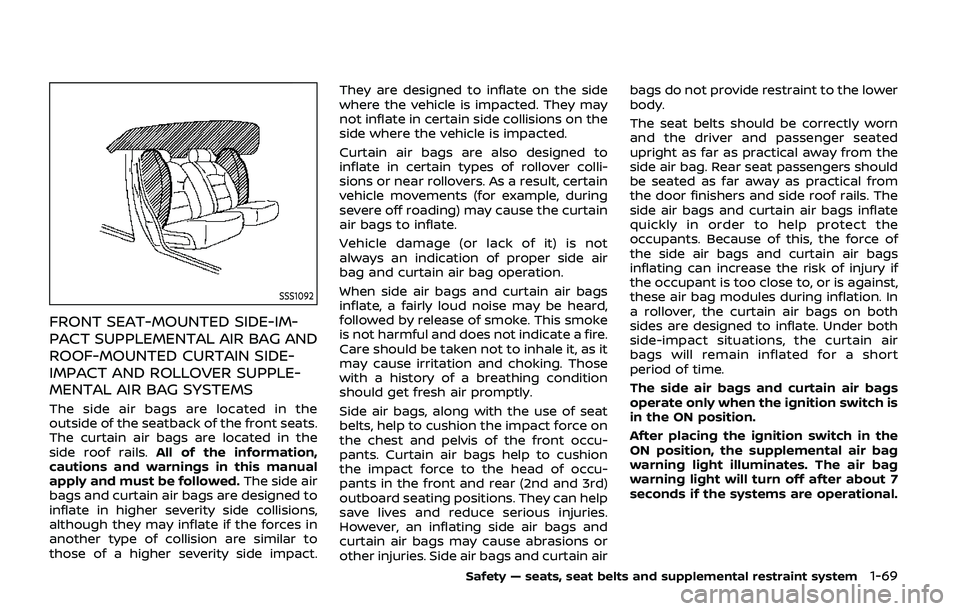
SSS1092
FRONT SEAT-MOUNTED SIDE-IM-
PACT SUPPLEMENTAL AIR BAG AND
ROOF-MOUNTED CURTAIN SIDE-
IMPACT AND ROLLOVER SUPPLE-
MENTAL AIR BAG SYSTEMS
The side air bags are located in the
outside of the seatback of the front seats.
The curtain air bags are located in the
side roof rails.All of the information,
cautions and warnings in this manual
apply and must be followed. The side air
bags and curtain air bags are designed to
inflate in higher severity side collisions,
although they may inflate if the forces in
another type of collision are similar to
those of a higher severity side impact. They are designed to inflate on the side
where the vehicle is impacted. They may
not inflate in certain side collisions on the
side where the vehicle is impacted.
Curtain air bags are also designed to
inflate in certain types of rollover colli-
sions or near rollovers. As a result, certain
vehicle movements (for example, during
severe off roading) may cause the curtain
air bags to inflate.
Vehicle damage (or lack of it) is not
always an indication of proper side air
bag and curtain air bag operation.
When side air bags and curtain air bags
inflate, a fairly loud noise may be heard,
followed by release of smoke. This smoke
is not harmful and does not indicate a fire.
Care should be taken not to inhale it, as it
may cause irritation and choking. Those
with a history of a breathing condition
should get fresh air promptly.
Side air bags, along with the use of seat
belts, help to cushion the impact force on
the chest and pelvis of the front occu-
pants. Curtain air bags help to cushion
the impact force to the head of occu-
pants in the front and rear (2nd and 3rd)
outboard seating positions. They can help
save lives and reduce serious injuries.
However, an inflating side air bags and
curtain air bags may cause abrasions or
other injuries. Side air bags and curtain airbags do not provide restraint to the lower
body.
The seat belts should be correctly worn
and the driver and passenger seated
upright as far as practical away from the
side air bag. Rear seat passengers should
be seated as far away as practical from
the door finishers and side roof rails. The
side air bags and curtain air bags inflate
quickly in order to help protect the
occupants. Because of this, the force of
the side air bags and curtain air bags
inflating can increase the risk of injury if
the occupant is too close to, or is against,
these air bag modules during inflation. In
a rollover, the curtain air bags on both
sides are designed to inflate. Under both
side-impact situations, the curtain air
bags will remain inflated for a short
period of time.
The side air bags and curtain air bags
operate only when the ignition switch is
in the ON position.
After placing the ignition switch in the
ON position, the supplemental air bag
warning light illuminates. The air bag
warning light will turn off after about 7
seconds if the systems are operational.
Safety — seats, seat belts and supplemental restraint system1-69
Page 96 of 536
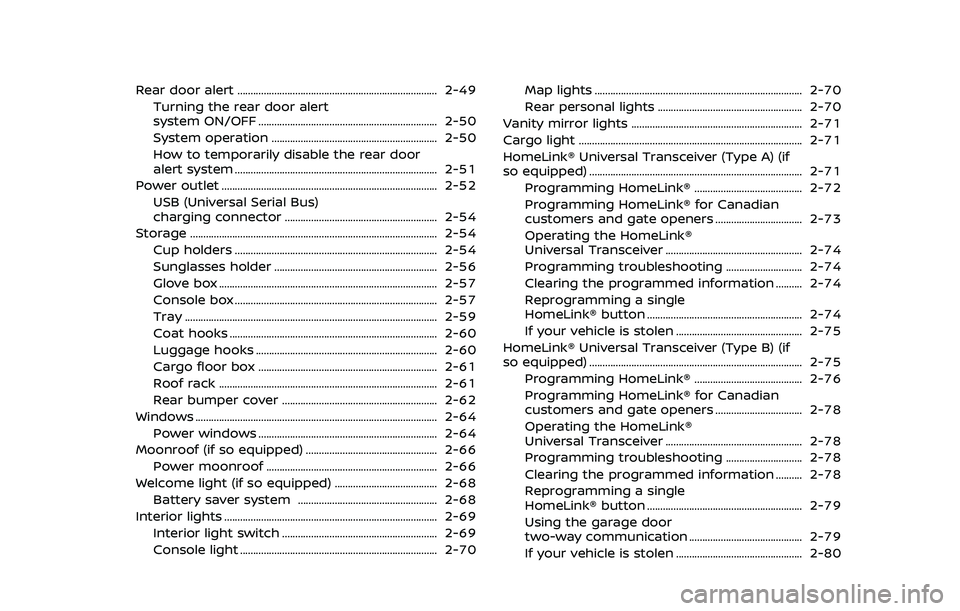
Rear door alert ........................................................................\
.... 2-49Turning the rear door alert
system ON/OFF .................................................................... 2-50
System operation ............................................................... 2-50
How to temporarily disable the rear door
alert system ........................................................................\
..... 2-51
Power outlet ........................................................................\
.......... 2-52 USB (Universal Serial Bus)
charging connector .......................................................... 2-54
Storage ........................................................................\
...................... 2-54 Cup holders ........................................................................\
..... 2-54
Sunglasses holder .............................................................. 2-56
Glove box ........................................................................\
........... 2-57
Console box ........................................................................\
..... 2-57
Tray ........................................................................\
........................ 2-59
Coat hooks ........................................................................\
....... 2-60
Luggage hooks ..................................................................... 2-60
Cargo floor box .................................................................... 2-61
Roof rack ........................................................................\
........... 2-61
Rear bumper cover ........................................................... 2-62
Windows ........................................................................\
.................... 2-64
Power windows .................................................................... 2-64
Moonroof (if so equipped) .................................................. 2-66 Power moonroof ................................................................. 2-66
Welcome light (if so equipped) ....................................... 2-68 Battery saver system ..................................................... 2-68
Interior lights ........................................................................\
......... 2-69
Interior light switch ........................................................... 2-69
Console light ........................................................................\
... 2-70 Map lights ........................................................................\
....... 2-70
Rear personal lights ....................................................... 2-70
Vanity mirror lights ................................................................. 2-71
Cargo light ........................................................................\
............. 2-71
HomeLink® Universal Transceiver (Type A) (if
so equipped) ........................................................................\
......... 2-71 Programming HomeLink® ......................................... 2-72
Programming HomeLink® for Canadian
customers and gate openers ................................. 2-73
Operating the HomeLink®
Universal Transceiver .................................................... 2-74
Programming troubleshooting ............................. 2-74
Clearing the programmed information .......... 2-74
Reprogramming a single
HomeLink® button ........................................................... 2-74
If your vehicle is stolen ................................................ 2-75
HomeLink® Universal Transceiver (Type B) (if
so equipped) ........................................................................\
......... 2-75
Programming HomeLink® ......................................... 2-76
Programming HomeLink® for Canadian
customers and gate openers ................................. 2-78
Operating the HomeLink®
Universal Transceiver .................................................... 2-78
Programming troubleshooting ............................. 2-78
Clearing the programmed information .......... 2-78
Reprogramming a single
HomeLink® button ........................................................... 2-79
Using the garage door
two-way communication ........................................... 2-79
If your vehicle is stolen ................................................ 2-80